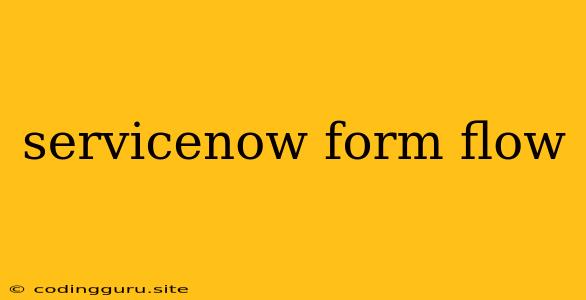Harnessing the Power of ServiceNow Form Flows: A Comprehensive Guide
ServiceNow, the leading platform for digital workflows, offers a powerful feature called Form Flows that revolutionizes how you design and automate your business processes. Form Flows enable you to create intuitive and engaging user experiences while streamlining your workflows, saving time and resources.
What are ServiceNow Form Flows?
In essence, Form Flows are guided experiences within ServiceNow forms. They act as a step-by-step wizard, guiding users through a series of questions and tasks. This structured approach ensures consistency, reduces errors, and enhances user satisfaction.
Why Use Form Flows?
- Simplify Complex Processes: Form Flows break down complicated processes into manageable steps, making them easier for users to understand and complete.
- Reduce Errors and Inconsistencies: By providing clear instructions and validation rules, Form Flows minimize the risk of human error and ensure data accuracy.
- Enhance User Experience: Form Flows offer a user-friendly interface, making it easier for users to navigate and complete tasks.
- Improve Efficiency: Form Flows automate repetitive tasks, freeing up your team to focus on higher-value activities.
- Increase Productivity: Form Flows provide a consistent and streamlined experience, boosting user productivity.
Creating Effective Form Flows: A Step-by-Step Guide
- Define the Process: Start by clearly defining the process you want to automate. Identify all the steps involved, the data required, and the desired outcome.
- Design the Flow: Create a flowchart or diagram to visualize the flow of the process. This will help you identify the key steps, decisions, and data required at each stage.
- Create the Form: Design a user-friendly form with clear instructions and intuitive navigation.
- Add Actions and Conditions: Utilize ServiceNow's extensive library of actions and conditions to automate tasks, manage approvals, and control the flow based on user input.
- Test and Refine: Thoroughly test your Form Flow to ensure it functions as expected. Identify any potential issues and make necessary adjustments.
- Deploy and Monitor: Once satisfied with the results, deploy your Form Flow and monitor its performance. Track key metrics like completion rates, time taken, and user feedback.
Examples of Form Flows in Action:
- Incident Management: A Form Flow can guide users through the incident reporting process, ensuring all necessary details are captured and the incident is properly escalated.
- Request Fulfillment: A Form Flow can streamline the request fulfillment process, from initial request submission to approval and fulfillment.
- Change Management: A Form Flow can guide users through the change management process, ensuring that changes are properly documented, reviewed, and implemented.
- Onboarding New Employees: A Form Flow can guide new employees through the onboarding process, ensuring they complete all necessary tasks and receive the information they need.
Tips for Creating Effective Form Flows:
- Keep it Simple: Avoid overwhelming users with too many steps or complex logic.
- Provide Clear Instructions: Use concise and easy-to-understand language.
- Use Visual Cues: Incorporate icons, progress bars, and other visual cues to enhance user experience.
- Offer Help: Provide context-sensitive help and FAQs to assist users.
- Test Thoroughly: Rigorously test your Form Flow before deployment.
Conclusion
ServiceNow Form Flows are a powerful tool for automating your business processes, enhancing user experience, and improving efficiency. By following these tips and best practices, you can design and implement Form Flows that meet your specific needs and drive tangible benefits for your organization.
